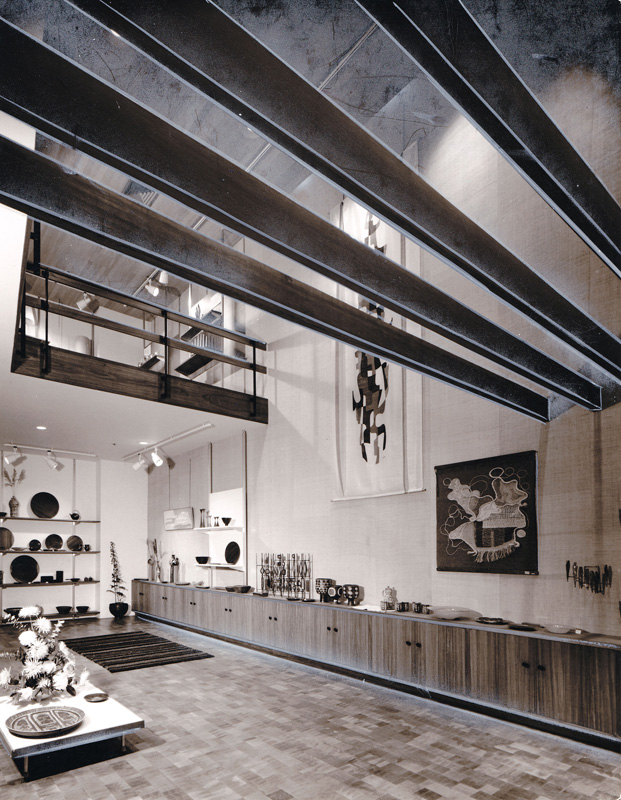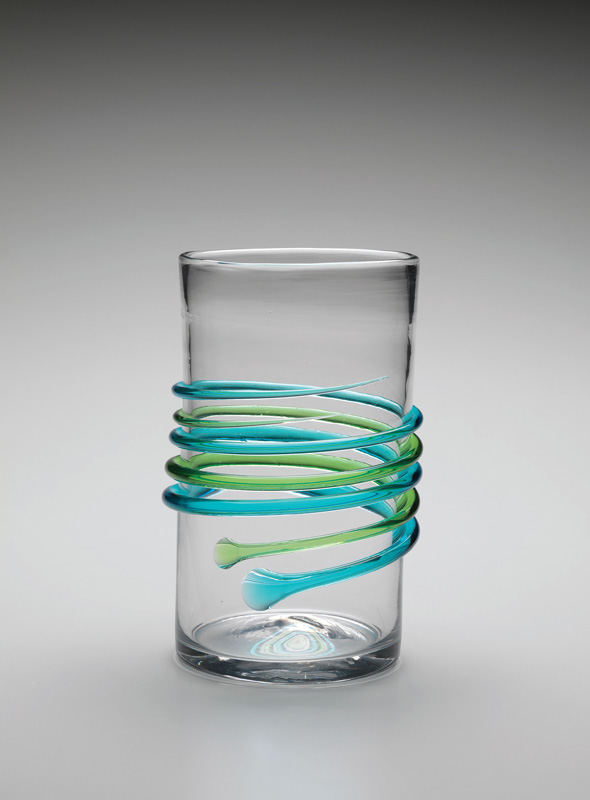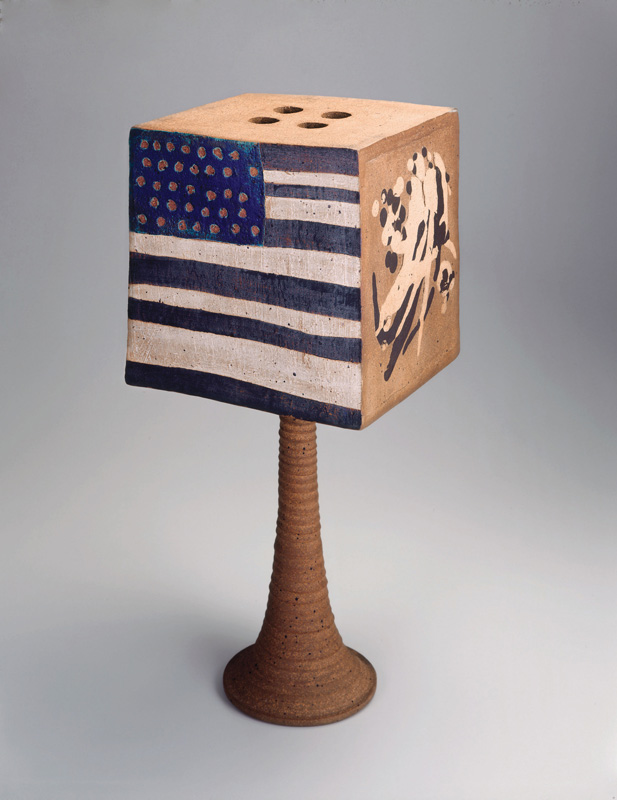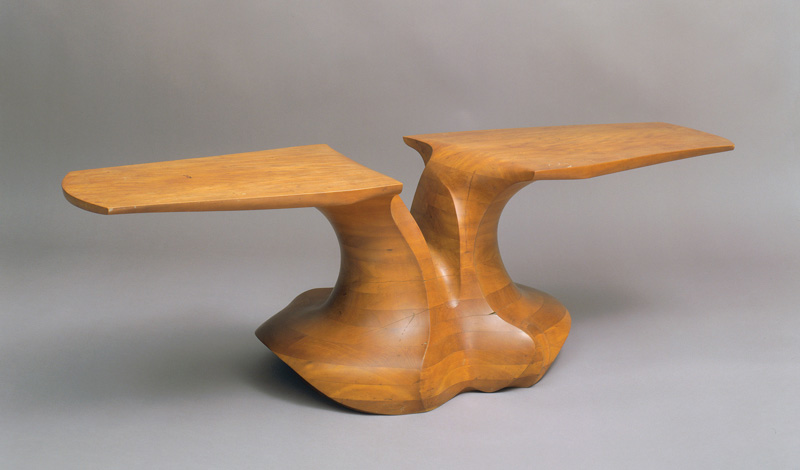from The Magazine ANTIQUES, July/August 2012 |

The April 1971 issue of Craft Horizons magazine featured a short essay titled “America House 1940-1971,” a eulogy, really, written by Aileen O. Webb for America House, a retail shop she had founded thirty years earlier.1 To the average reader of Craft Horizons (also founded by Mrs. Webb)2 this was not such a big deal. However, if you went on to read the essay beneath it, “America House: An Appreciation” written by Harriet Cohen, a ceramist whose work regularly sold at the shop, the closing was a “tremendous blow” to American craftsmen.3 Though the shop had fulfilled its mission to bring American crafts to a wider public, those who sold their work there would miss it as they would a trusted friend.
Aileen Osborn Webb (Mrs. Vanderbilt Webb) came from a family of art patrons: her father, William Church Osborn, was the president of the Metropolitan Museum of Art; her uncle, Henry Fairfield Osborn, was the president of the American Museum of Natural History; and her sister-in-law, Electra Havemeyer Webb (Mrs. James Watson Webb), would establish the Shelburne Museum in Vermont in 1947.

During the Depression, Aileen Webb had begun a crafts group called Putnam County Products in her hometown of Peekskill, New York, to help local craftsmen sell their wares. Recognizing the need for an organization that would aid members of the many craft leagues around the country find wider markets for their products, she became the guiding light in the formation of the Handcraft Cooperative League of America in 1940.4 The league decided to establish a shop that would offer crafts of the finest quality from across the country, and chose New York-home to the most discerning customers-as its location. The name “America House” was suggested by league member Laurits Christian Eichner, a pewter craftsman.
Prior to the opening of America House, the selection of American handmade crafts available to the public was limited. A letter sent to potential consignors identified the shop’s main goal as providing a “central location for the sale and distribution of American handicrafts.”5 America House would act as an agent and would help craftsmen decide on prices, wholesale and retail, that would be fair to both them and the shop. In the beginning objects were taken on consignment and the shop was run as a cooperative, with everyone involved owning a two dollar share of stock (it became a corporation in 1951). Craftsmen were asked to submit their work through their group, or league, to ensure that only the best was sent on to the shop; by 1943 this had changed and craftsmen began to submit their work directly. To help regulate prices and ensure that buyers in search of the best American crafts would always come to America House, makers were expected to make the shop the sole outlet for their work.

From the early days, Mrs. Webb was supported by a group of dedicated individuals who eventually became America House’s board of trustees: Dorothy Liebes, Dorothy Schaffer, Dorothy Draper, May Walter, Alfred Auerbach, Walter H. Kilham, Frank Stanton, and Edward J. Wormley. Frances Wright Caroé (1890-1959), the youngest daughter of Frank Lloyd Wright by his first marriage, was the main liaison between the artists and the shop, traveling the country and selecting the very best to bring back with her. Her daughter, who often traveled with her, remembers Caroé making suggestions to the craftspeople she met about how to improve their production methods and better market their work.6 As the first director of the shop, she took her “counseling” a step further by publishing an advice column called “Prevailing Winds” in Craft Horizons (the first installment appeared in the August 1947 issue). Introducing the column, she wrote that in it she would pull “no punches…for here are met the realities as dollars and cents which are as sharp as a cutting tool, as tricky as a glaze, intricate as a loom dressing, as manipulative as silver, as smooth as molten crystal, and completely fickle as color, form, and function.”7 Caroé tried to get her father involved with America House and sent him samples of upholstery fabrics from the shop that she hoped he would show to his clients and use in their houses. Caroé left America House in 1952 under uncertain circumstances, but in her unpublished memoir written many years later, Mrs. Webb acknowledged that Caroé’s “vision of the future of crafts was far ahead of mine.”8

A central location was crucial to the shop since accessibility was part of its mission. Over the course of its thirty-year history, America House had four different addresses: it opened in October 1940 at 7 EastFifty-Fourth Street, then in October 1943 moved to 485 Madison Avenue at Fifty-Second Street. To save money on rent, in September 1949 it moved to the back of the same building, giving up the Madison Avenue storefront for a 32 East Fifty-Second Street address; in September 1960 it settled in its most glamorous venue at 44 West Fifty-Third Street.
Mrs. Webb carried the American-made theme of the shop into its interior color scheme. According to photograph captions in the May 1943 issue of Craft Horizons, the walls of the first shop were dep blue and white, the curtains striped red and white, and a bald eagle-the symbol of America House-graced the front door. When the shop moved to 485Madison Avenue Dorothy Draper, the well-known interior decorator and a founding member, continued the red, white, and blue color scheme. It was not until the shop moved to Fifty-Third Street, a space renovated by David K. Campbell, that this patriotic color scheme was abandoned.9 Campbell chose to outfit the new space, four floors and a mezzanine, in rough brick, pandanus cloth, and wood-textures that would complement the products sold. The shop also had a patio for outdoor art installations.10 All the decorative elements and furnishings were made by craftsmen associated with America House. For his work, Campbell was awarded a prize by the Fifth Avenue Association for the best design of a renovated New York building in 1961.

The roster of artists who sold through America House reads like a who’s who in American crafts: Elsa Freund, Michael Coffey, Wharton Esherick, Paolo Soleri, Jere Osgood, Ronald Hayes Pearson, Earl Pardon, Tage Frid, Marguerite Wildenhain, to name just a few. Wendell Castle met Mrs. Webb when he moved to New York in 1961. He sent pictures of his work to America House and met with Florence Eastmead, then the shop’s director. She showed them to Mrs. Webb, who purchased “three of his best pieces for herself”11 and retailed the rest through America House. Of the “best pieces” one was the coffee table in Figure 17, which Mrs. Webb’s son later donated to what is today the Museum of Arts and Design. One of Castle’s earliest and most important works, the “Kafka-like” Scribe’s Stool, was featured in the shop’s 1962 Young Americans exhibition and illustrated in the July-August 1962 issue of Craft Horizons.12 Castle was also commissioned to build jewelry cases for the Fifty-Third Street location. Of the importance of America House, he says, “there has never been anything that has come close to replacing it. Everyone who was important at the time of the shop’s existence sold their work there.”13
Dorsey Reading, who was assistant to the metalsmith and designer Paul Evans for twenty-three years beginning in 1959, confirms that “Evans’s involvement with America House helped launch his career. To have his pieces go straight from his New Hope studio to Madison Avenue was a supreme way to reach clients.” As with some of her other artists, Mrs. Webb became Evans’s patron. She helped him secure a scholarship to the Cranbrook Academy of Art and then a fellowship to Sturbridge Village in Massachusetts. Though Evans became the designer at Directional Furniture Company in 1963 he continued his affiliation with America House through 1965, offering them pieces from his highly successful Sculpted Front series.14

Evans and Phillip Lloyd Powell, with whom he shared his studio, partook in a well-reviewed exhibition at America House in 1961 that included thirty tables, chairs, cabinets, and screens of their design. Reading remembers that one of Evans’s room-high vertical wall dividers was shown in the shop window. Powell equated the 1961 exhibition with “winning the Acadmy Awards” and said “it put me on the map.”15 Not long before his death in 2008 he told a journalist that Mrs. Webb “was my angel. We used to call her ‘Mrs. Arts and Crafts.'”16 Evans and Powell also worked closely with the America House’s Interior Design Consultation Services to create one-of-a-kind pieces for clients.
Ceramists Michael and Harriet Cohen sold their pottery at the shop for a decade, from 1961 to 1971, and considered it their best customer. Since they were located in New Hampshire, America House allowed them to reach clients that they ordinarily would not have had access to. Cohen recalls that each trip to the shop “was incredibly exciting because it gave me the opportunity to see what other people…were doing.” It was the place to “see the best craftwork in the country.”17
While America House was predominantly a retail operation, it occasionally hosted small non-selling exhibitions as part of the initiatives set forth by the American Craftsmen’s Educational Council to teach consumers about American crafts.18 The first such show, The Modern Embroideries of Mariska Karasz, opened on September 7, 1949. The idea for the Museum of Contemporary Crafts (now the Museum of Arts and Design), which Mrs. Webb founded in 1956, developed out of these special exhibitions. It opened on September 20, 1956, at 29 West Fifty-Third Street; its inaugural exhibition, Craftsmanship in a Changing World, featured 314 objects by 180 craftsmen from nineteen states, most of whom had exhibited at or sold through America House.
America House also showcased the work of the winners of the Young Americans competitions conducted by the Educational Council. The competitions, held annually between 1950 and 1956 and then periodically through 1988, were open to American craftsmen thirty years old or younger working in any medium. In 1952 a young Paul Evans won first prize in the metal category for a silver and rosewood coffeepot, quite different from the metal furniture he would exhibit and retail through the shop in the 1960s. The Young Americans competitions were judged by a distinguished panel that, over the years, included Edgar Kaufmann Jr., Ruth Reeves, Grete Franke, and Art Smith (himself a past winner).
In the 1960s America House singled out individual artists by displaying their work in a gallery-like space within the shop called the “Collector’s Room.” 19 One 1968 advertisement for the Collector’s Room (Fig. 7) featured a music stand by Castle for $350, a far cry from the price the piece would command today.
All of Mrs. Webb’s organizations were inextricably linked and supported each other. For example, the most talented students at the School for American Craftsmen, which she founded in 1944, sold their work at America House, as did the faculty. Harold Brennan, the director, wrote that the school “used America House as a clinical laboratory, providing a testing ground of the most rigorous sort for design, technical handling, and price.”20
In the last decade of its existence America House, under director Bill Hodges, tried to implement new ideas for attracting clients and to improve features already in place. A “selection board” was established to approve all the work offered for sale; a mail-order catalogue was issued; a wider selection of home furnishings was offered; and an architecture and interior design consultation service was initiated to pair clients with America House craftsmen.21 Actually, Caroé had conceived the idea of an interior design service in the 1940s, though it was not realized at that time. During the late 1950s and 1960s privately owned branches of America House were opened across the country-in Sun Valley, Idaho; Birmingham, Michigan; and in the Frederick and Nelson department store in Seattle.
In her press statement on the closing of America House, Mrs. Webb said that the shop had accomplished the goal set forth thirty years earlier.22 As promised, America House had offered its customers an extensive selection of handmade, some one-of-a-kind, pieces made by master craftsmen. But by 1971 American crafts were no longer an anomaly, and the desire for them had never been stronger. Mission accomplished.
I would like to thank Jeannine Falino at the Museum of Arts and Design for her guidance and support.
BELLA NEYMAN is a design historian and journalist living in Brooklyn. Her areas of specialization are twentieth-century decorative arts, fashion, and jewelry.
1 Aileen O. Webb, “America House 1940-1971,” Craft Horizons, vol. 31, no. 2 (April 1971), p. 11. 2 An untitled magazine was published by the Handcraft Cooperative League in November 1941 and was sent to all the craftsmen associated with the shop. The first issue of Craft Horizons (the title given to it by Maginel Wright Barney, Frank Lloyd Wright’s niece) was published in May 1942. In June 1979 Craft Horizons was renamed American Craft. The magazine was overseen by the American Craftsmen’s Cooperative Council (see n. 4). 3 Harriet Cohen, “America House: An Appreciation,” Craft Horizons, vol. 31, no. 2, pp. 11, 57. 4 The Handcraft Cooperative League of America merged with the American Handcraft Council in May 1942 to become the American Craftsmen’s Cooperative Council, which, after several reincarnations, became known as the American Craft Council (ACC) on July 27, 1979. The American Craftsmen’s Educational Council and the School for American Craftsmen, which Mrs. Webb founded in 1944, were both affiliated with the organization. 5 Undated letter from the Handcraft Cooperative League of America, courtesy of ACC. 6 Author’s interview with Nora Natof, June 23, 2010. Caroé also taught courses on production and marketing at the School for American Craftsmen. 7 Frances Wright Caroé, “Prevailing Winds,” Craft Horizons, vol. 8, no. 18 (August 1947), p. 68. 8 Aileen O. Webb, “Almost a Century,” c. 1977, p. 71, Archives of American Art, Washington, D. C. 9 Campbell was also the president of the ACC and director of the Museum for Contemporary Crafts. This new building was also the ACC headquarters and home for Craft Horizons magazine. 10 “Interior Design Data: Crafts Store,” P/A (February 1961), pp. 154-157. 11 Author’s interview with Wendell Castle, June 28, 2010. 12 Oppi Untracht, “Young Americans 1962: Enamels, Glass, Wood, Bronze,” Craft Horizons, vol. 22, no. 4 (July/August 1962), pp. 19-20. 13 Author’s interview with Castle. 14 Author’s interview with Dorsey Reading, July 8, 2010. 15 Louise Devenish, “Phillip Lloyd Powell: A Reminiscence,” at http://1stdibs.com/articles/creators/powell/index.php 16 Ibid. 17 Author’s interview with Michael Cohen, June 28, 2010. 18 Aileen O. Webb, “Almost a Century,” p. 94. Mrs. Webb had asked her friend Helen Watkins to organize some smaller shows as early as 1945. 19 “The Collector’s Room,” Outlook: American Craftsmen’s Council Newsletter, vol. 6, no. 8 (December 1965). 20 Harold Brennan, “The School for American Craftsmen,” Craft Horizons, vol. 20, no. 3 (May/June 1960), pp. 21-24. 21 Charles Burwell, “The New America House and its Policies” ibid., no. 5 (September/October 1960), pp. 50-51. 22 “America House Closes,” Outlook: American Craftsmen’s Council Newsletter, vol. 12, no. 1 (February 1971).
